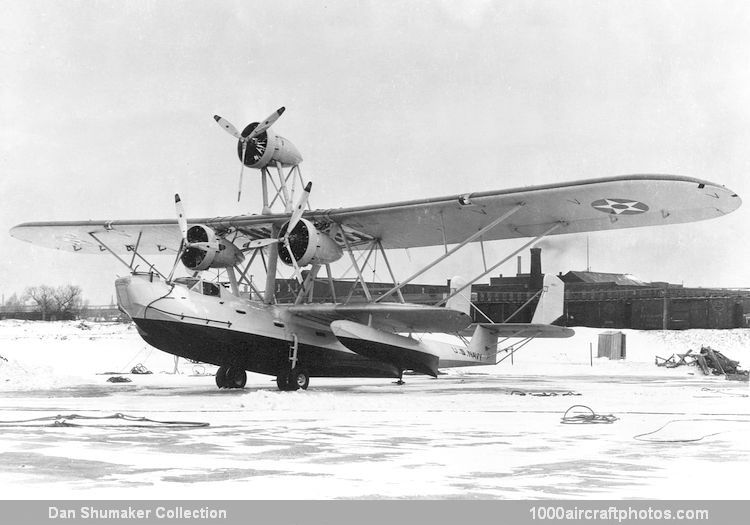09/30/2014. Remarks by Johan Visschedijk: "Although Consolidated lost the production contract for the Model 9 PY-1 Admiral to Martin (P3M), Chief Engineer Isaac Machlin 'Mac' Laddon continued to improve the design as the Buffalo, New York plant was completing Commodore production. A single prototype Model 22 XP2Y-1 was ordered on May 26, 1931, followed on July 7 by a production contract for 23 P2Y-1s (BuNos. A-8986 to A-9008, c/n 1 to 23).
The P2Y-1 had the same 100 ft (30.48 m) parasol wing as the PY-1 Admiral, but became a sesquiplane with a 45 ft 3 in (13.79 m) span wing mounted lower, at the top of the hull, replacing the struts that had supported the stabilizing floats. The cockpit was now enclosed in Commodore style and two 575 hp Wright R-1820-E1 Hornets were installed beneath the top wing with a third, similar engine, strut-mounted on the center line above the wing. All three engines were enclosed by NACA narrow-chord ring cowlings and riveted alloy fuel tanks were built into the wings.
First flown by Bill Wheatley and Clinton P. Warner (with Laddon also aboard) from Buffalo on March 26, 1932, the XP2Y-1 was tested at NAS Anacostia, Washington, District of Columbia, the following month. The third engine was discarded and testing began with the twin-engined version on May 18. All P2Y-1s were delivered between December 22, 1932, and June 27, 1933, in this configuration to VP-10 and VP-5. Six P2Y-1s of the latter squadron set a new non-stop formation flight distance record between Hampton Roads, Norfolk, Virginia, and Coco Solo, Canal Zone (2,058 mls, 3,312 km) on 7-8 September, 1933, in 25 hr 19 min under the command of Lt. Cdr. Donald M. Carpenter.
A second long-distance formation flight occurred when VP-10 was transferred to Pearl Harbor, Hawaii, from Coco Solo. Six newer P2Y-1s with longer range were passed to VP-10 from VP-5 and these left the Canal Zone on a fourteen-hour flight to Acapulco, Mexico, on October 7, 1933, then on to San Diego, California. On January 10, 1934, the six P2Y-1 s left Alameda, California, for Pearl Harbor led by Lt. Cdr. Knefler 'Soc' McGinnis and his co-pilot, Cdr. Marc A. Mitscher, arriving safely the next day despite having flown throughout the night in fog. The elapsed time was 24 hr 56 min for the 2,408 mls (3,875 km). President Franklin D. Roosevelt sent a telegram congratulating the men "on the greatest undertaking of its kind in the history of aviation."
The last Navy P2Y-1 (BuNo. A-9008) on the production line was modified to the XP2Y-2 in August 1933 with 750 hp R-1820-88s raised to the leading edge of the wing in NACA cowlings. The change reduced drag considerably and 21 P2Y-1s were thus modified as P2Y-2s with kits supplied by Consolidated. Two unmodified aircraft were built for export. The P2Y-1C (c/n 1) was delivered to Colombia on December 31, 1932, and remained in service until 1948; the P2Y-1J (21966) to Japan in January 1935. Assembled by Kawanishi, the latter was flown on April 12 and used for comparative tests; then saw airline service during WW II.
On December 27, 1933, the Navy ordered 23 P2Y-3s (c/n 1 to 23, BuNos. A-9551 to A-9571, A-9618, A-9619) which were of similar configuration but with R-1820-90 engines and additional 420 gal (1,590 l) fuel to make a total capacity of 1,635 gal (6,189 l). The first aircraft was delivered to VP-7 in January 1935, followed by VP-4. In 1939, the P2Y was operational with VP-14, VP-15, VP-19, VP-20, and VP-21 but by the end of 1941, all P2Ys had been withdrawn from use and stored at Pensacola.
Six P2Y-3Ss with GR-1820-F52 engines were ordered by Argentina in May 1936 and delivered in August-September 1937 to replace Supermarine Southamptons. This batch brought total production to 55 aircraft. In service with Escuadrilla de Patrulleros at Puerto Belgrano, the P2Y-3As continued in use until replaced by PBYs in 1947."
